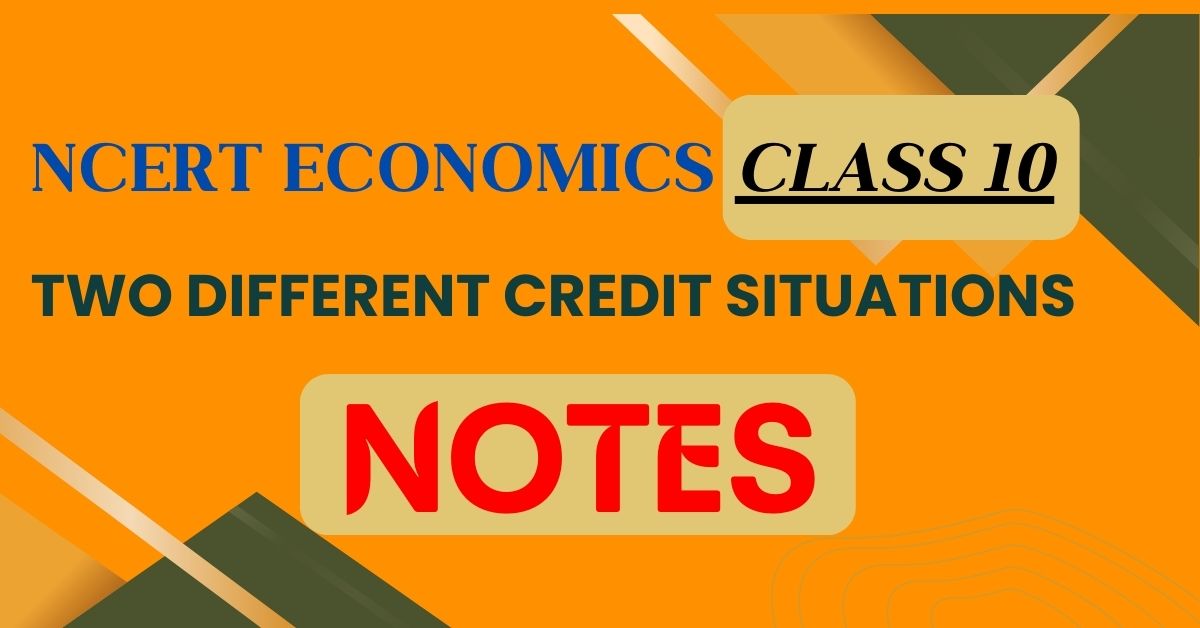NCERT Economics Class 10 | Two Different Credit Situations Notes
Topic & sub-topics covered: Two Different Credit Situations: Money and Credit (All single detail notes are exam-oriented).
We have discussed in-depth and exam-oriented pointers that can be asked in the board exam of class 10th about “Two Different Credit Situations” which is taken from the NCERT Economics notes for class 10th chapter 3 “Money and Credit“.
Download the NCERT Economics for Class 10th Chapter 3 Money and Credit Notes PDF
Looking to grasp the concepts of money and credit in NCERT Economics for Class 10th? Look no further! Download the comprehensive Chapter 3 Money and Credit Notes PDF now and unlock a treasure trove of knowledge.
NCERT Class 10 Economics Chapter 3 Money and Credit Class 10th PDF Notes
Delve into the intricacies of monetary systems, explore the role of credit in the economy, and understand the mechanisms of banking and financial institutions. Our meticulously prepared notes provide concise explanations, illustrative examples, and insightful analysis to deepen your understanding of this crucial subject. With a clear focus on exam preparation and academic excellence, our PDF notes offer a structured approach to learning, helping you grasp complex concepts with ease.
Gain confidence in your knowledge and ace your exams with the help of our top-quality study material. Don’t miss out on this opportunity to elevate your learning experience – download the NCERT Economics for Class 10th Chapter 3 Money and Credit Notes PDF today!
Two Different Credit Situations
1. Definition of Credit:
- Credit, also known as a loan, involves an agreement where the lender provides money, goods, or services to the borrower with the expectation of future repayment.
2. Role of Credit in Transactions:
- Credit plays a crucial role in day-to-day activities by enabling individuals and businesses to access resources they need before making full payment, thereby facilitating economic transactions.
Let us see how credit works through the following two examples:
(A) Festival Season
1. Scenario Description:
- Salim, a shoe manufacturer, receives a bulk order for 3,000 pairs of shoes to be delivered within a month during the festival season.
2. Use of Credit in Production:
- Salim utilizes credit to meet the working capital requirements of production.
- He obtains loans from two sources: a leather supplier and a large trader who advances cash as an advance payment for a portion of the order.
3. Benefits of Credit:
- Credit enables Salim to procure raw materials and hire additional workers, facilitating the timely completion of production.
- By successfully utilizing credit, Salim can fulfil the order, earn a profit, and repay the borrowed money, highlighting the positive role of credit in business operations.
(B) Swapna’s Problem
1. Scenario Description:
- Swapna, a small farmer, faces challenges with her groundnut crop due to pest infestation, leading to crop failure and accumulation of debt.
2. Demand for Credit in Rural Areas:
- The main demand for credit in rural areas is for crop production, involving costs like seeds, fertilisers, pesticides, etc.
- Farmers typically take crop loans at the beginning of the season and repay after harvest, with repayment dependent on farming income.
3. Consequences of Crop Failure and Debt:
- Crop failure leads to an inability to repay loans, resulting in a debt trap for farmers like Swapna.
- Swapna’s situation illustrates how credit, instead of improving earnings, exacerbates financial distress, forcing her to sell part of her land.
4. Debt Trap and Risk Mitigation:
- A debt trap occurs when credit pushes borrowers into a situation of worsening financial conditions, making recovery difficult.
- Whether credit is beneficial depends on the risks involved and the availability of support in case of loss, highlighting the importance of risk management in credit utilization.
Next & Previous Topics of NCERT/CBSE Economics Class 10 Chapter 3: Money and Credit
FAQ
Q1. What is credit?
Answer: Credit, also known as a loan, involves an agreement where the lender provides money, goods, or services to the borrower with the expectation of future repayment.
Q2. How does credit benefit businesses during the festival season?
Answer: Salim, a shoe manufacturer, utilizes credit to meet working capital requirements for production. He obtains loans from suppliers and traders, enabling timely production, order fulfilment, profit generation, and repayment.
Q3. What challenges can farmers face with credit, as illustrated by Swapna’s situation?
Answer: Swapna, a small farmer, faces crop failure and debt accumulation due to pest infestation. Despite credit being vital for farming, crop failure can lead to a debt trap, exacerbating financial distress and necessitating risk management in credit utilization.
Q4. How does credit impact economic transactions?
Answer: Credit plays a crucial role by enabling individuals and businesses to access resources they need before making full payment, thereby facilitating economic transactions.

